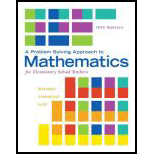
Concept explainers
A teacher instructed her class to take any number and perform a series of computations using that number. The teacher was able to tell each student’s answers. Create similar instructions for students so that the teacher needs to do only the following to obtain the student’s original number,
a. Add 1 to the answer.
b. Multiply the answer by 2.
c. Multiply the answer by 1.
Want to see the full answer?
Check out a sample textbook solution
Chapter 8 Solutions
Problem Solving Approach to Mathematics for Elementary School Teachers, A, Plus MyLab Math -- Access Card Package (12th Edition)
Additional Math Textbook Solutions
Beginning and Intermediate Algebra
Elementary & Intermediate Algebra
Pathways To Math Literacy (looseleaf)
Elementary Statistics ( 3rd International Edition ) Isbn:9781260092561
College Algebra (Collegiate Math)
Finite Mathematics for Business, Economics, Life Sciences and Social Sciences
- xp x+xarrow_forwardFor the given graph, determine the following. -3 12 УА 4 3 - -1 ° 1 2 3 x -1. -2- a. Determine for which values of a the lim f (x) exists but f is not continuous at x = a. a b. Determine for which values of a the function is continuous but not differentiable at x = a. aarrow_forwardI write with prove one-to-one linear Sanction but not onto Lexample.) b) write with Prove on to linear function but not oh-to-on (example). c) write with prove example x=y St Xandy two linear space over Sielad F.arrow_forward
- Use the following graph of ƒ (x) to evaluate ƒ' (−1) and ƒ' (2). y +10+ 9 8 7 6 5 4 3 2 1- -10 -9 -8 -7 -6 -5 -4 -3 -2 -1 x 3 4 0 8 9 10 -2 3 -4 5 -6 -7 -8 -9 -10- f'(-1)= f' (2)arrow_forwardFor the following function f and real number a, a. find the slope of the tangent line mtan = = f' (a), and b. find the equation of the tangent line to f at x = a. f(x) = 2 = ;a=2 a. Slope: b. Equation of tangent line: yarrow_forwardFor the following function f and real number a, a. find the slope of the tangent line mtan = f' (a), and b. find the equation of the tangent line to f at x = a. f(x) = 2x² + 3x; a = 2 a. Slope: b. Equation of tangent line: yarrow_forward
- For the following function f and real number a, find f' (a). f(x) = = √x+4; a = 0 f' (a)arrow_forwardFind the slope of the secant line between the values x₁ and x2 for the function y = f (x). Answer exactly or round to 2 decimal places. f(x) = √√x x7; x₁ = 11, x2 = 23 Slope:arrow_forwardFor the following function f and real number a, find f' (a). f(x)=8x+6; a = −3 f' (a)arrow_forward
- Find the slope of the secant line between the values 1 and 2 for the function y = f(x). Answer exactly or round to 2 decimal places. 2 f(x)= ; = x12, x24 2, x2 = 4 2x 1 Slope: Submit Questionarrow_forwardanswer a, b, and carrow_forwardA population of muffles (a feathery species unrelated to tribbles) begins with 30 animals and has 100 animals after 36 hours.arrow_forward
 Mathematics For Machine TechnologyAdvanced MathISBN:9781337798310Author:Peterson, John.Publisher:Cengage Learning,
Mathematics For Machine TechnologyAdvanced MathISBN:9781337798310Author:Peterson, John.Publisher:Cengage Learning, Algebra: Structure And Method, Book 1AlgebraISBN:9780395977224Author:Richard G. Brown, Mary P. Dolciani, Robert H. Sorgenfrey, William L. ColePublisher:McDougal Littell
Algebra: Structure And Method, Book 1AlgebraISBN:9780395977224Author:Richard G. Brown, Mary P. Dolciani, Robert H. Sorgenfrey, William L. ColePublisher:McDougal Littell
 Holt Mcdougal Larson Pre-algebra: Student Edition...AlgebraISBN:9780547587776Author:HOLT MCDOUGALPublisher:HOLT MCDOUGAL
Holt Mcdougal Larson Pre-algebra: Student Edition...AlgebraISBN:9780547587776Author:HOLT MCDOUGALPublisher:HOLT MCDOUGAL Elementary AlgebraAlgebraISBN:9780998625713Author:Lynn Marecek, MaryAnne Anthony-SmithPublisher:OpenStax - Rice UniversityAlgebra & Trigonometry with Analytic GeometryAlgebraISBN:9781133382119Author:SwokowskiPublisher:Cengage
Elementary AlgebraAlgebraISBN:9780998625713Author:Lynn Marecek, MaryAnne Anthony-SmithPublisher:OpenStax - Rice UniversityAlgebra & Trigonometry with Analytic GeometryAlgebraISBN:9781133382119Author:SwokowskiPublisher:Cengage





